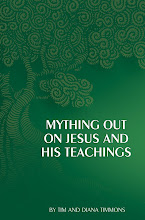There is an old story that illustrates how myths originate and are passed on from generation to generation. It’s about a family that always cut their turkey in half before they cooked it. This was certainly very odd by American tradition since everybody always served a whole baked turkey as the centerpiece for the Thanksgiving meal.
For many years this strange ritual went on until a child from the fourth generation decided he was going to find out why his family had such a very “strange” tradition. So he went up to his Momma and asked “why exactly do we cut the turkey across the middle whenever we cook one for Thanksgiving?”
Somewhat startled by such a sensible inquiry, the mother decided to ask her mom exactly the same question the youngest had put across: “Momma, Why ‘do’ we cut the turkey in half?”
Grandma for her part could only scratch her chin and reply, “to tell you the truth, I can’t exactly tell why. All I know is that was how I saw my momma do it, and that’s how I’ve done it all these years. Why don’t we ask Great Grand Nanny!”
So they all huddled around the Matriarch as Grandma asked, Momma, why exactly do you always cut the thanksgiving turkey in half before you stick it in the oven?
Great Grandma sat her self up and with a look of disbelief she replied, “Did you never realize that our oven was never big enough to stick a whole turkey in? That’s why I always had to cut those turkeys in two,”
Do you see how easily this happens? Now transfer this same understanding of myth development over to the world of spiritual things. Many times the myth emerges out of partial knowledge. You know there is nothing more dangerous than a person who has read only one book on a subject. From the basis of that book and that author opinions are formulated and become fact, until another person offers a different thought on the subject. I am reminded of the man who came to the conclusion about all native American Indians. He said, “All Indians walk single file, at least, the one I saw did.” It’s a partial perspective!
Myths also tend to be developed with a prejudiced perspective. Whereas a partial perspective is when you don’t have all of the facts, the prejudiced perspective is when you don’t want the facts. The facts might mess up what you already believe!
A man sat in front of his doctor, claiming that he knew that he was dead. The doctor assured him that he wasn’t dead—depressed, maybe, but very much alive. Nothing would change the patient’s mind on the issue. So, the doctor sent him on a research project to the medical library. The research would conclusively prove that “dead men don’t bleed.”
When the patient finished his research, he returned to see his doctor. The doctor asked, “What did the research say?” “Well,” said the patient, “it is clear that the medical literature says that dead men don’t bleed.”
“Perfect!” replied the doctor. The doctor immediately went over to the patient, stuck a needle in his arm, and the man began to bleed. Without any hesitation the patient jumped up and proclaimed, “Dead men do bleed!” Now, that’s a prejudiced perspective! Don’t confuse me with the facts. My mind is already made up! Especially is this common within religious circles!
There is one other perspective that breeds myths. It’s what I call a passive perspective. A passive perspective is when you have the facts, but don’t act upon them. You are committed, but not involved in the behavior that the commitment requires. This is, by far, an epidemic in our society! Committed, but not involved! You know what to do in your marriage, but don’t do it. You know what to do with your children, but don’t do it. You know what to do in the midst of a conflict, but don’t do it. You know what to do with your priorities, but you don’t do it. It’s like the kamikaze pilot who made 33 missions. He was committed, but not involved!
As we examine the person and teachings of Jesus we want to know as much as we can from Jesus, Himself. We want to examine Jesus and His teachings as objectively as possible. And, we want to examine Jesus and His teachings actively and not passively. This last approach can make the most difference. I don’t want this examination of Jesus and His teachings to be just another intellectual exercise. It’s one thing to know Jesus and His teachings and quite another thing altogether to do your best to follow Jesus: Follow Jesus because of His impeccable character and life. As you continue to follow Jesus, you will find His teachings to be most meaningful and fulfilling. And, if you embrace following Jesus as your lifestyle, you may discover how to relate to your Creator in a personal way.
